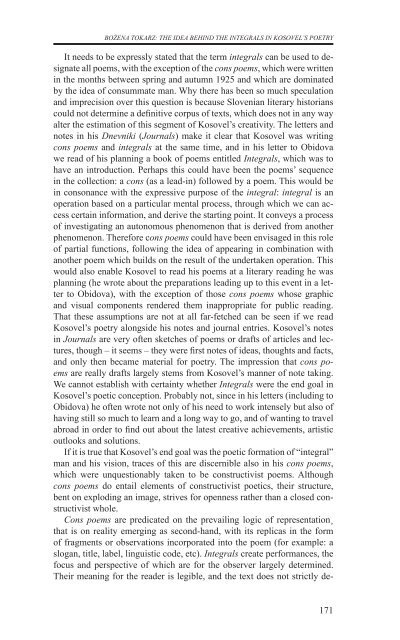razprave (pdf) - Društvo za primerjalno književnost - ZRC SAZU
razprave (pdf) - Društvo za primerjalno književnost - ZRC SAZU
razprave (pdf) - Društvo za primerjalno književnost - ZRC SAZU
- No tags were found...
You also want an ePaper? Increase the reach of your titles
YUMPU automatically turns print PDFs into web optimized ePapers that Google loves.
Bożena Tokarz: The Idea behind the Integrals in Kosovel’s PoetryIt needs to be expressly stated that the term integrals can be used to designateall poems, with the exception of the cons poems, which were writtenin the months between spring and autumn 1925 and which are dominatedby the idea of consummate man. Why there has been so much speculationand imprecision over this question is because Slovenian literary historianscould not determine a definitive corpus of texts, which does not in any wayalter the estimation of this segment of Kosovel’s creativity. The letters andnotes in his Dnevniki (Journals) make it clear that Kosovel was writingcons poems and integrals at the same time, and in his letter to Obidovawe read of his planning a book of poems entitled Integrals, which was tohave an introduction. Perhaps this could have been the poems’ sequencein the collection: a cons (as a lead-in) followed by a poem. This would bein consonance with the expressive purpose of the integral: integral is anoperation based on a particular mental process, through which we can accesscertain information, and derive the starting point. It conveys a processof investigating an autonomous phenomenon that is derived from anotherphenomenon. Therefore cons poems could have been envisaged in this roleof partial functions, following the idea of appearing in combination withanother poem which builds on the result of the undertaken operation. Thiswould also enable Kosovel to read his poems at a literary reading he wasplanning (he wrote about the preparations leading up to this event in a letterto Obidova), with the exception of those cons poems whose graphicand visual components rendered them inappropriate for public reading.That these assumptions are not at all far-fetched can be seen if we readKosovel’s poetry alongside his notes and journal entries. Kosovel’s notesin Journals are very often sketches of poems or drafts of articles and lectures,though – it seems – they were first notes of ideas, thoughts and facts,and only then became material for poetry. The impression that cons poemsare really drafts largely stems from Kosovel’s manner of note taking.We cannot establish with certainty whether Integrals were the end goal inKosovel’s poetic conception. Probably not, since in his letters (including toObidova) he often wrote not only of his need to work intensely but also ofhaving still so much to learn and a long way to go, and of wanting to travelabroad in order to find out about the latest creative achievements, artisticoutlooks and solutions.If it is true that Kosovel’s end goal was the poetic formation of “integral”man and his vision, traces of this are discernible also in his cons poems,which were unquestionably taken to be constructivist poems. Althoughcons poems do entail elements of constructivist poetics, their structure,bent on exploding an image, strives for openness rather than a closed constructivistwhole.Cons poems are predicated on the prevailing logic of representation¸that is on reality emerging as second-hand, with its replicas in the formof fragments or observations incorporated into the poem (for example: aslogan, title, label, linguistic code, etc). Integrals create performances, thefocus and perspective of which are for the observer largely determined.Their meaning for the reader is legible, and the text does not strictly de-171
















